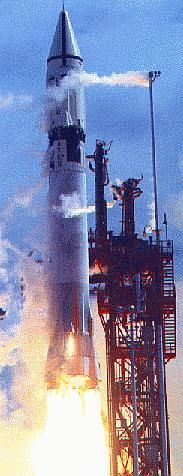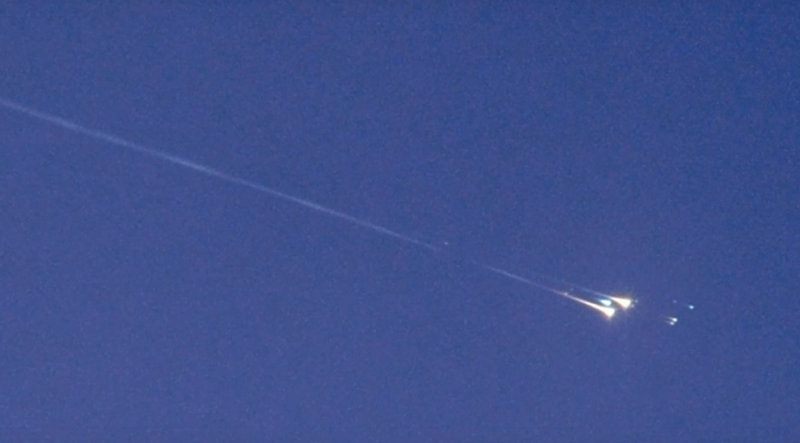
Asteroid or space junk? Strange space object 2020 SO was discovered on September 17, 2020 on approach to Earth. It’ll likely be captured by Earth, briefly becoming a mini-moon. In this image, the Earth is the blue dot in the center. The moon’s orbit is the white circle. Image via Tony Dunn (@tony873004 on Twitter).
An approaching space object – labeled 2020 SO – is about to briefly become a new “mini-moon” for Earth, captured by our planet’s more powerful gravity. Orbit models show that both the low speed and trajectory of the approaching object indicate Earth will capture it, temporarily, from October 2020 perhaps until around May 2021. It won’t be the first time Earth has captured a mini-moon, but this object is unusual and perhaps no ordinary asteroid. It might be a lost rocket, originally launched from Earth more than 50 years ago.
On September 17, 2020, astronomers sighted the object on approach to Earth, using the 71-inch (1.8-meter) Pan-STARRS1 telescope at Maui, Hawaii. They designated it as asteroid 2020 SO and added it as an Apollo asteroid in the JPL Small-Body Database.
However, 2020 SO has some features that set it apart from ordinary asteroids. According to NASA/JPL calculations, the object will soon pass by Earth’s moon at a speed of 1,880 miles per hour (3,025 km/h) or 0.84 km per second (.5 mi/sec). That is an extremely slow speed for an asteroid.
These calculations also show the apparent “slow asteroid” orbiting the sun every 1.06 years (387 days). The low relative velocity, along with the Earth-like orbit, suggest it can be an artificial object that might have been launched from our planet.
Paul Chodas, manager of NASA’s Near Earth Object center at the Jet Propulsion Laboratory in Pasadena, California, suggested the object might be the rocket booster of Surveyor 2, a robotic spacecraft that was launched to the moon on September 20, 1966.
The Surveyor 2 mission was meant to send the second lunar lander in the uncrewed American Surveyor program to explore the moon. The Surveyor 2 spacecraft blasted into space atop an Atlas LV-3C Centaur-D rocket from Cape Kennedy, Florida. A mid-course correction failure caused space controllers to lose contact with the craft three days later, after a thruster failed to ignite. The failure caused the spacecraft to tumble and ultimately to crash near the moon’s Copernicus crater.

An Atlas LV-3C Centaur-D launch on June 30, 1964. Image via AstroNautix.
Speed ahead to our time and the strange object designed 2020 SO. The object has an estimated size between 20 and 45 feet (6 to 14 meters), a not-unreasonable match for the dimensions of an Atlas LV-3C Centaur-D (approximately 41 feet or 12 meters).
How could we have lost an entire 41-foot-long rocket? Space archaeologist Alice Gorman of Flinders University in Australia told ScienceAlert that – before our modern era of reuseable rockets – the rockets that launched craft into space were surprisingly easy to lose. She said:
There are so many factors in the space environment, like gravitational factors and other things that affect movement, that it can sometimes be quite unpredictable.
You have to keep tracking these things, or you can just sort of lose sight of them really easily. And if they do something a little bit unpredictable, and you look the wrong way, then you don’t know where it’s gone. It is quite astonishing, the number of things that have gone missing.
Is 2020 SO an ordinary asteroid? Or is it an old earthly rocket returning home? We just don’t know yet.
Scientists hope that further observations and spectroscopic observations of light reflected from the surface of 2020 SO, will allow us to know if it’s in fact a strange, slow space rock, or human-made space debris.
By the way, this isn’t the first time Earth has captured a mini-moon.
As you might have realized by now, space is chock full of small asteroids. Once in a while, one of these space rocks is captured, temporarily, by our planet’s gravity before being cast out back into the solar system at large. Two confirmed mini-moons are 2006 RH120 (in Earth orbit between 2006 and 2007), and 2020 CD3 (in our orbit between 2018 and 2020).
It’s also not the first time we’ve mistaken space junk for an asteroid.
Another small object that was initially thought to be an asteroid was WT1190F, detected in October 2015 on approach to Earth. Its trajectory suggested it was about to penetrate Earth’s atmosphere near Sri Lanka, in the Indian Ocean, an event that happens with ordinary asteroids several times every year.
As WT1190F was disintegrating in our atmosphere on November 13, 2015, scientists analyzed its light via spectroscopy.
This analysis suggested the object might be a spacecraft component or part of a spent rocket, another wandering piece of space junk, returning home.

Object tagged as WT1190F entering Earth’s atmosphere south of Sri Lanka on November 13, 2015. Image via IAC/ UAE/ NASA/ ESA.
Bottom line: A newly discovered “asteroid” might become a new mini-moon for Earth. This object is designated 2020 SO and was entered in JPL’s Small-Body Database. But it might be no ordinary asteroid. It might be a lost rocket from the Surveyor 2 mission, originally launched from Earth more than 50 years ago.
from Hacker News https://ift.tt/304Kzwx
No comments:
Post a Comment
Note: Only a member of this blog may post a comment.